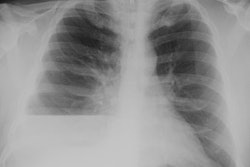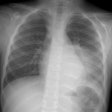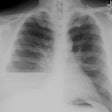TNM Staging of Malignant Mesothelioma:
(From: AJR 1999; Heelan RT, et al. Staging of malignant pleural mesothelioma: Comparison of CT and MR imaging. 172: 1039-1047 and Radiographics 2004; Wang ZF, et al. Malignant pleural mesothelioma: evaluation with CT, MR imaging, and PET. 24: 105-119)Stage:
Stage I:
Ia: T1aN0M0
Ib: T1bN0Mo
Stage II:
T2N0M0
Stage III:
T3 Any N M0
N1 or N2 Any T M0
Stage IV:
Any T4
Any N3
Any M1
T Stage: Size/extent of primary tumor
T1:T1a: Tumor limited to the ipsilateral parietal pleura, including mediastinal and diaphragmatic pleura, but no visceral pleural involvementT2:
T1b: Tumor involving the ipsilateral parietal pleura, including mediastinal and diaphragmatic pleura, with scattered foci of tumor also involving the visceral pleura
Tumor involving each of the ipsilateral pleural surfaces (parietal, mediastinal, diaphragmatic, and visceral) with at least one of the following features:T3:- Involvement of diaphragmatic muscle
- Confluent visceral pleural tumor (including the fissures) or extension of tumor from the visceral pleura into the underlying pulmonary parenchyma
Locally advanced but potentially resectable tumor that involves all the ipsilateral pleural surfaces (parietal, mediastinal, diaphragmatic, and visceral) with at least one of the following features:T4:- Involvement of the endothoracic fascia
- Extension into the mediastinal fat
- Non-transmural involvement of the pericardium- A solitary completely resectable focus of tumor that extends into the soft tissues of the chest wall
Locally advanced technically unresectable tumor that involves all the ipsilateral pleural surfaces with at least one of the following features:- Diffuse extension or multifocal massess of tumor in the chest wall, with or without associated rib destruction
- Direct transdiaphragmatic extension of tumor to the peritoneum
- Direct extension of tumor to the contralateral pleura
- Direct extension of tumor to one or more mediastinal organs
- Direct extension of tumor into the spine
- Tumor extending through to the internal surface of the pericardium with or without pericardial effusion or involving the myocardium
N Stage: Presence of regional nodal disease
N0: No regional node metastasesN1: Mets to the ipsilateral bronchopulmonary or hilar lymph nodes
N2: Mets to the subcarinal or ipsilateral mediastinal nodes, including ipsilateral internal mammary nodes
N3: Mets to the contralateral mediastinal, contralateral internal mammary, or ipsilateral/contralateral supraclavicular nodes
M Stage: Presence of distant metastases
M0: No distant metsM1: Distant mets present




